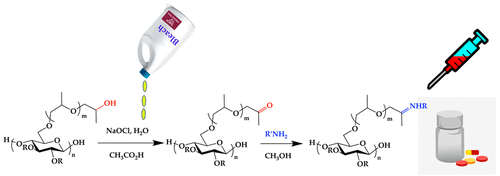当前位置:
X-MOL 学术
›
Biomacromolecules
›
论文详情
Our official English website, www.x-mol.net, welcomes your
feedback! (Note: you will need to create a separate account there.)
Selective Oxidation of 2-Hydroxypropyl Ethers of Cellulose and Dextran: Simple and Efficient Introduction of Versatile Ketone Groups to Polysaccharides
Biomacromolecules ( IF 5.5 ) Pub Date : 2020-11-25 , DOI: 10.1021/acs.biomac.0c01045 Brittany L B Nichols 1 , Junyi Chen 1 , Petra Mischnick 2 , Kevin J Edgar 3, 4
Biomacromolecules ( IF 5.5 ) Pub Date : 2020-11-25 , DOI: 10.1021/acs.biomac.0c01045 Brittany L B Nichols 1 , Junyi Chen 1 , Petra Mischnick 2 , Kevin J Edgar 3, 4
Affiliation

|
Oxidation of polysaccharides has been a useful approach to new materials. However, selectivity in oxidation of polysaccharide macromolecular polyols remains a significant challenge with few methods for the synthesis of ketone-substituted polysaccharides. We report here a selective, practical, and efficient process, beginning with 2-hydroxypropyl ethers of polysaccharides that are simple and economical to prepare. We demonstrate this approach herein using commercial 2-hydroxypropyl cellulose (HPC) and 2-hydroxypropyl dextran (HPD) that we prepared. We oxidize the terminal, secondary alcohols of the oligo(2-hydroxypropyl) substituents with sodium hypochlorite so that the product has an oligo(2-hydroxypropyl) side chains terminated by a ketone. We demonstrate the high chemo- and regioselectivity of this oxidation by analytical methods including hydrolysis to monosaccharides and mass spectrometry of the resulting mixture. We provide an initial demonstration of the potential utility of these keto-polysaccharides by reacting Ox-HPC with primary amines to form Schiff base imines, providing proactive polymers.
中文翻译:

纤维素和右旋糖酐的2-羟丙基醚的选择性氧化:将多功能酮基简单有效地引入多糖中
多糖的氧化一直是新材料的有用方法。然而,用很少的方法合成酮取代的多糖,多糖大分子多元醇的氧化选择性仍然是一个重大挑战。我们在这里报告了一种选择性,实用和有效的方法,从简单且经济的多糖2-羟丙基醚开始。我们在本文中使用我们准备的商业2-羟丙基纤维素(HPC)和2-羟丙基葡聚糖(HPD)演示了这种方法。我们用次氯酸钠氧化低聚(2-羟丙基)取代基的末端仲醇,使产物具有被酮封端的低聚(2-羟丙基)侧链。我们通过分析方法证明了这种氧化的高化学选择性和区域选择性,包括水解成单糖和质谱分析所得混合物。我们通过使Ox-HPC与伯胺反应形成席夫碱亚胺,提供了活性聚合物,初步证明了这些酮多糖的潜在用途。
更新日期:2020-12-14
中文翻译:

纤维素和右旋糖酐的2-羟丙基醚的选择性氧化:将多功能酮基简单有效地引入多糖中
多糖的氧化一直是新材料的有用方法。然而,用很少的方法合成酮取代的多糖,多糖大分子多元醇的氧化选择性仍然是一个重大挑战。我们在这里报告了一种选择性,实用和有效的方法,从简单且经济的多糖2-羟丙基醚开始。我们在本文中使用我们准备的商业2-羟丙基纤维素(HPC)和2-羟丙基葡聚糖(HPD)演示了这种方法。我们用次氯酸钠氧化低聚(2-羟丙基)取代基的末端仲醇,使产物具有被酮封端的低聚(2-羟丙基)侧链。我们通过分析方法证明了这种氧化的高化学选择性和区域选择性,包括水解成单糖和质谱分析所得混合物。我们通过使Ox-HPC与伯胺反应形成席夫碱亚胺,提供了活性聚合物,初步证明了这些酮多糖的潜在用途。











































 京公网安备 11010802027423号
京公网安备 11010802027423号